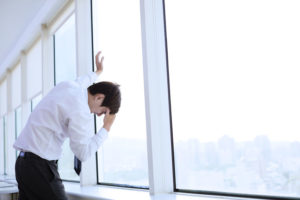
Indoor Air Quality and Sick Building Syndrome

You’ve probably heard of Sick Building Syndrome. Sick buildings are one of the many reasons that the environmental testing services offered by AirMD – including VOC testing, formaldehyde testing and mold testing as well as asbestos inspections – are in such demand by businesses from Boca Raton and Miami to Orlando and Jacksonville.
If you’ve ever had the misfortune of working in a sick building, you know all too well how it makes you feel, but you probably don’t know why the building made you feel that way. (If you haven’t had the experience – trust us, you don’t want to.) That’s part of the problem with Sick Building Syndrome – no one is able to identify exactly what causes it.
What Makes a Building Sick?
Sick Building Syndrome is a relatively recent addition to the world of illness and disease. The problem began when we stopped opening the windows in the buildings where we live, work, shop and go to school. During the energy crisis of the 1970s, in an effort to save on energy consumption, new construction featured virtually air-tight environments.
What seemed like a good idea at the time had unintended consequences. Unfortunately, in addition to keeping air-conditioned or heated air in, these buttoned-up buildings can also trap a number of airborne contaminants.
As Occupational Health & Safety magazine explains, “Many paints, carpet fibers, furniture, and even wallboard off-gas noxious fumes, sometimes for years after installation. These products may emit formaldehyde, acetic acid, or volatile organic compounds (VOCs) and other chemicals. Modern office equipment such as copiers and electrostatic air cleaners add to the problem by adding ozone to the mix. Mold or mildew from damp conditions also create air quality problems. Manufacturing processes and material-handling equipment may add hydrocarbons or smog, and many chemical cleaning agents give off harmful vapors. The result is a chemical stew in the air that makes people ill—with sick building syndrome.”
Symptoms of Sick Building Syndrome
A long list of symptoms can be associated with Sick Building Syndrome, including but not limited to:
- Nasal congestion
- Itchy eyes
- Headaches
- Sinus infections
- Shortness of breath
- Nosebleeds
- Chronic fatigue
- Mental fogginess
- Scratchy throat
- Dry, irritated skin
- Upset stomach
How do you know if you have Sick Building Syndrome? Do you start to feel better on vacation or even over a long weekend? As WebMD says, “The telling factor is if the symptoms ease when workers are at home or on vacation.
Is It Time for Formaldehyde Testing in your Workplace?
According to an article by Sumedha M. Joshi in the Indian Journal of Occupational & Environmental Medicine, “The sick building syndrome (SBS) is used to describe a situation in which the occupants of a building experience acute health- or comfort-related effects that seem to be linked directly to the time spent in the building. No specific illness or cause can be identified. The complainants may be localized in a particular room or zone or may be widespread throughout the building.”
“This feeling of ill health increases sickness absenteeism and causes a decrease in productivity of the workers. As this syndrome is increasingly becoming a major occupational hazard, the cause, management and prevention of this condition have been discussed in this article.”
If you aren’t the only one suffering from similar symptoms or if you notice increased rates of absenteeism, you may want to consider indoor air quality testing.
If you have questions about Sick Building Syndrome, please remember that the scientists at Boca Raton-based AirMD, a leader in VOC testing, asbestos inspections and formaldehyde testing as well as mold testing and remediation., are available to assist you.






